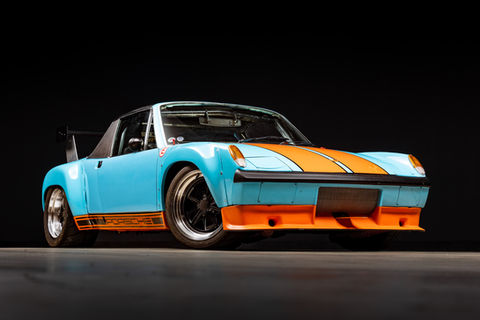
1974 Porsche 914 V8
CAR DETAILS
Drive Train
GM 383 V8
6-speed manual Boxster
Color
Blue
Tartan
Numbers
1454 miles
THE MODEL
By 1974, the Porsche 914 had matured into its most refined form, solidifying its place as a true driver's car. Still a joint venture between Porsche and VW, the ’74 model year marked the introduction of the appearance group as standard on the 914/4, bringing fog lights, dual horns, center console with auxiliary gauges, and vinyl-covered sail panels—a nod to Porsche’s growing attention to premium touches.
Engine choices included the robust 1.8L flat-four (76 hp) with Bosch L-Jetronic fuel injection—introduced that year to replace the 1.7L—and the more spirited 914 2.0 (91 hp), which remained the enthusiast’s choice thanks to its superior torque curve, lighter weight, and better-balanced chassis dynamics. The 1.8's arrival also signaled growing emissions regulation compliance, especially in U.S. markets.
The mid-engine layout, near 50/50 weight distribution, and low curb weight (~2,100 lbs) gave the 914 a level of handling precision that few contemporaries could match. Despite criticism of its austere interior and VW underpinnings, the 914 rewarded skilled drivers with impeccable road feel and balance.
Cosmetically, 1974 saw urethane bumper guards to meet U.S. 5-mph standards, and various bright colors like Phoenix Red and Bumblebee/Can Am LE editions added flair. The 914/6 was long gone, but the 2.0 kept the performance flag flying.
Today, the '74 model is often considered a sweet spot for collectors—refined, better-equipped, and with the later engineering improvements, while still retaining the purity of the original 914 ethos. The 2.0, in particular, remains the connoisseur's choice.
THE ENGINE
The GM 383 stroker isn’t a factory production engine per se, but rather a legendary small-block Chevy (SBC) build that combines the best of displacement, torque, and rev-happy performance. Born from hot-rodders’ ingenuity, the 383 uses a 400ci small-block crankshaft (3.75” stroke) stuffed into a 350ci block (4.00” bore), creating a longer-stroke, high-torque small-block that maintains relatively compact external dimensions.
By increasing the stroke over the standard 350, the 383 delivers a broad torque curve—ideal for street machines, muscle cars, and light trucks. Depending on camshaft selection, compression ratio, and induction setup, naturally aspirated 383s can produce 400–500+ hp and torque numbers in the same ballpark, with a meaty low-end and midrange ideal for real-world performance.
The 383's popularity exploded in the late '80s and '90s, and today it's a staple of crate engine catalogs, custom builds, and restomod applications. GM Performance Parts even embraced the configuration with its own 383 crate engines, such as the ZZ383 and HT383E, offering reliability and factory-backed performance for builders seeking turnkey powerplants.
While purists may still revere the high-winding 327 or the brute force of a big-block 454, the 383 remains a near-perfect balance of displacement, weight, and versatility, embodying the spirit of the SBC with a modern torque twist.
THE CAR
Full details coming soon...
COMING SOON!
Email ingo@genauautowerks.com
or call 415.730.5352 for more information





























